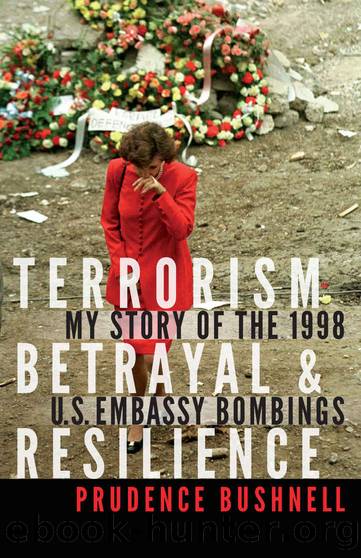Terrorism, Betrayal, and Resilience: My Story of the 1998 U.S. Embassy Bombings by Prudence Bushnell

Author:Prudence Bushnell [Bushnell, Prudence]
Language: eng
Format: azw3
Tags: POL037000 Political Science / Terrorism, BIO010000 Biography & Autobiography / Political, HIS001020 History / Africa / East
ISBN: 9781640121331
Publisher: Potomac Books
Published: 2018-09-30T16:00:00+00:00
8
The Blowback
1990: Washington DC, New York City
The United States was at peace with the Soviet Union for the first time in fifty years, and Ronald Reagan’s vice president had been elected president. George H. W. Bush inherited a world in transition. Domestically he struggled with an economic recession, increased unemployment, and a significant budget deficit. Internationally he faced the breakup of the Soviet Union and the emergence of what he called “a new world order.” When Iraq invaded Kuwait in the summer, Bush faced a new world order crisis and called up the troops for Operation Desert Storm. Unlike many of his predecessors, Bush had both foreign policy experience and interest, having served as ambassador to China and director of the CIA. Although the Soviets were out of Afghanistan, the president continued to approve the policy to back our favored Pakistan-vetted local militias in what was now a civil war. The Soviets funded their favored militias as well. Each side hoped “his” guys would win. Meanwhile, wannabe jihadists kept coming into the area even though the infidels had left. A reporting officer in the U.S. embassy noticed. These were “well-financed Arab fanatics, extolling a virulent anti-American line, in contrast to the embassy perception of the groups that have been supported by the United States during the conflict with the Soviet Military forces.”1
In the United States, some of these recruits had come to the attention of New York City’s Joint Terrorism Task Force (JTTF). Made up of New York City police and members of the local FBI office, the JTTF learned that members of the al-Kifah Refugee Center and al-Farooq Mosque were negotiating for illegal arms. Someone later photographed men from al-Kifah receiving arms training at a shooting range near New York City. What were they training for? Was the Afghan war over or not? It was an open secret that the “refugee center” had links to the CIA, so the JTTF figured the CIA would know.2 What was certain, for anyone who looked closely enough, was that al-Kifah was a busy place.
One week on Atlantic Avenue, it might be a CIA-trained Afghan rebel travelling on a CIA-issued visa; the next, it might be a clean-cut Arabic-speaking Green Beret, who would lecture about the importance of being part of the mujahedin, or “warriors of God.” The more popular lectures were held upstairs in the roomier Al-Farooq Mosque; such was the case in 1990 when Sheikh Abdel-Rahman, travelling on a CIA-supported visa, came to town. The blind Egyptian cleric, with his ferocious rhetoric and impassioned preaching, filled angry, discontented Arab immigrants with a fervor for jihad—holy war. This was exactly what the CIA wanted: to stir up support for the Muslim rebels and topple the Soviet-backed government in Afghanistan.3
Download
This site does not store any files on its server. We only index and link to content provided by other sites. Please contact the content providers to delete copyright contents if any and email us, we'll remove relevant links or contents immediately.
| Arms Control | Diplomacy |
| Security | Trades & Tariffs |
| Treaties | African |
| Asian | Australian & Oceanian |
| Canadian | Caribbean & Latin American |
| European | Middle Eastern |
| Russian & Former Soviet Union |
The Secret History by Donna Tartt(16653)
The Social Justice Warrior Handbook by Lisa De Pasquale(11492)
Thirteen Reasons Why by Jay Asher(7797)
This Is How You Lose Her by Junot Diaz(5792)
Weapons of Math Destruction by Cathy O'Neil(5045)
Zero to One by Peter Thiel(4833)
The Myth of the Strong Leader by Archie Brown(4795)
Promise Me, Dad by Joe Biden(4453)
Beartown by Fredrik Backman(4429)
Stone's Rules by Roger Stone(4422)
How Democracies Die by Steven Levitsky & Daniel Ziblatt(4408)
The Fire Next Time by James Baldwin(4349)
100 Deadly Skills by Clint Emerson(4084)
A Higher Loyalty: Truth, Lies, and Leadership by James Comey(4038)
Rise and Kill First by Ronen Bergman(4017)
The David Icke Guide to the Global Conspiracy (and how to end it) by David Icke(3890)
The Farm by Tom Rob Smith(3878)
Secrecy World by Jake Bernstein(3787)
The Doomsday Machine by Daniel Ellsberg(3736)
